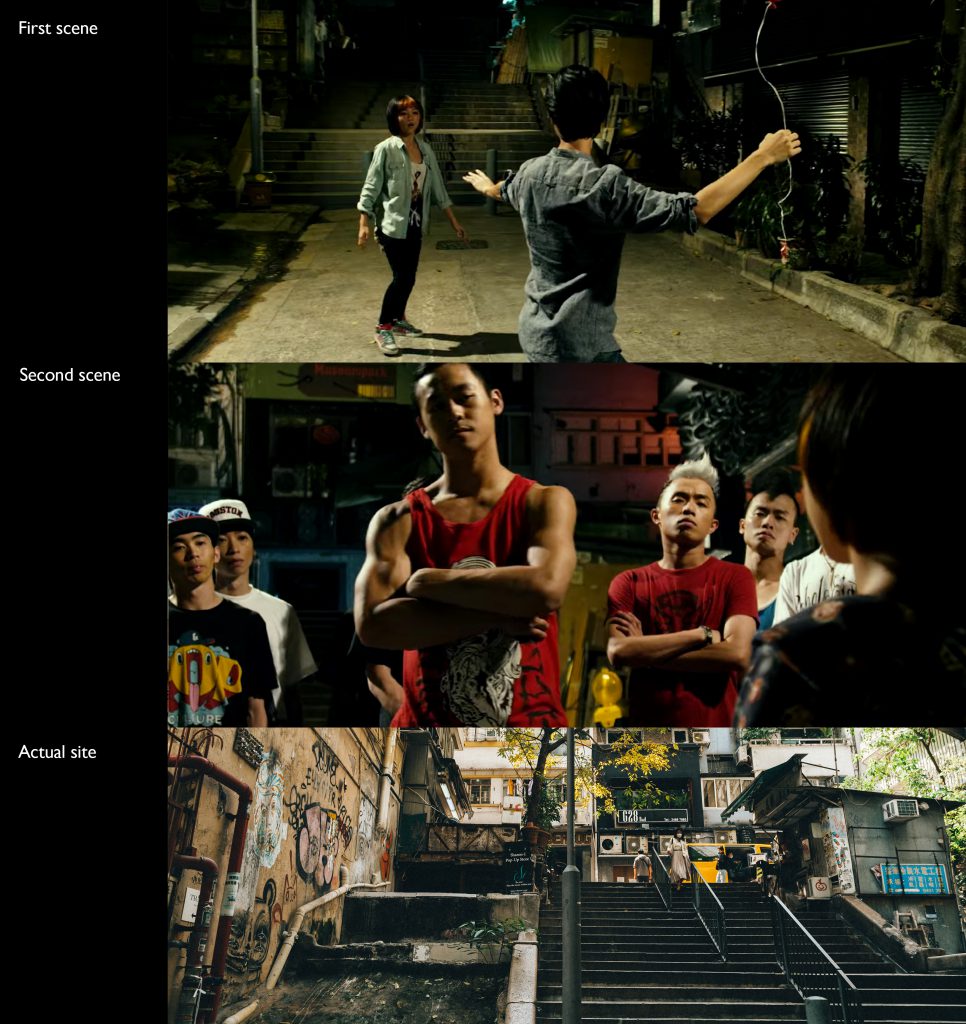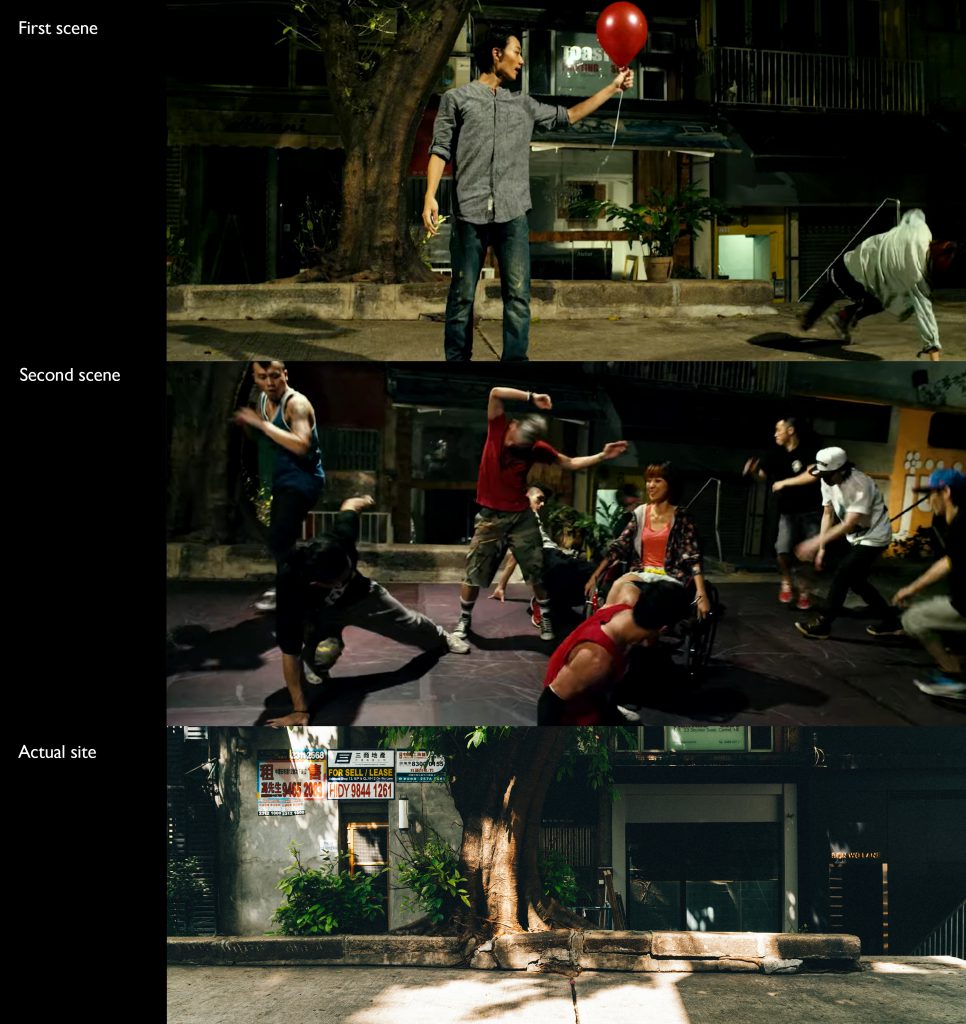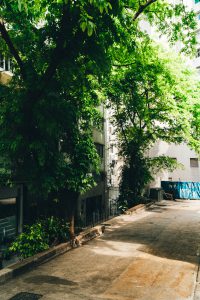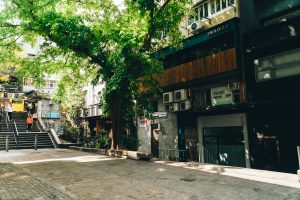THE WAY WE DANCE; Adam Wong Sau Ping, 2013
On Wo Lane, Central, Hong Kong
Dancing is all about passion, youth and dream. It is something magical to Fa, a gifted wannabe street dancer who gave up her family business to join the university dance team. Through battling and competing, Fa and her teammates went through conflicts and reunification and eventually discovered their unique choreography style by blending Tai Chi into street dance. At On Wo Lane in Central, a nostalgic back alley where she encountered Tai Chi enthusiast Alan and dancing rival Stormy, she found her love and discovered the unimaginable power of dreams. Despite the site appeared only twice in the movie, the impact and transition it brought to the plot is significant. Connecting Kau U Fong and Gough Street, On Wo Lane consists of a wide alley with staircases at one end that creates the height difference. The lane is surrounded by old residential buildings of approximately 5 storeys and a gigantic tree that spans up to 15 meters tall.
On Wo Lane was being presented in the movie with very different atmospheres during its two appearances. In the first scene when Fa and Alan were catching a red balloon hung on the gigantic tree and danced romantically, the lane was presented as a wide and peaceful urban space. Not only the broadness was presented, but also the height of the space as the two travelled from the top of the stairs to jumping up and down at the lower end of the lane. During the second scene, a more compressed perspective was being implemented. Together with more obstacles such as roadblocks being placed on the ground, a tenser atmosphere was being presented. The lane was no longer a romantic place for dating but where Fa met her dancing rivals. Audiences cannot feel the spaciousness of the lane as fast dancing and intensity of the group of rivals translated the space into a ground for battle. In reality, the site is more similar to the way it was presented in the first scene. The lane is even more spacious than it was presented in the film and there were very few pedestrians. As it is separated from roads, the urban free space was very quiet with a relaxed atmosphere. Some people would stop by and sit on the steps to enjoy break time where they were allowed to escape from the busy and fast-paced Central. A special remark is that numerous graffiti was observed on the sides wall of the lane but they were not existing when the movie was filmed in 2012, it is possible that the hip-hop culture presented in the film influenced individuals and made an impact on the film site itself.


The contrast in the method of presentation of the same site was crucial to linking the transition of the plot and allowed audiences to follow the characters’ emotion change along with the movie. Director Adam Wong did not choose to film the two scenes at different sites but particularly repeating the events at On Wo Lane, with the first scene presented in a relaxed and spacious atmosphere while the second in an intense atmosphere. This can be reflected by Fa’s emotional change from her romantic relationship with placid Alan to her difficult moments when she encountered conflicts with Alan, broke her leg and lost motivation in dancing. In addition, the gigantic tree on Wo On Lane was used as a linking symbolism for the love memories she had with Alan when she looked at it alone in a wheelchair. Such a spatial arrangement successfully recalls and relates to the development of their relationship.


All in all, Wo On Lane acted as an important site in the movie ‘The Way We Dance’, the director successfully translated the void of the urban space into different atmospheres which guided the transition of the plot and character development. More importantly, it is fascinating how the nostalgic alley surrounded by 1960s buildings were being presented in a modern film about street dancing, echoing the main theme of the movie that blends traditional Tai Chi into pop culture Hip Hop and at the end creating a unique style of dancing. The site truly demonstrated how traditions and creativeness can blend well together and reminds our city that we should take advantage of our rich history and innovative minds to discover new possibilities.
Tang King To Anson, 3035797963
You have made a good attempt in identifying On Wo Lane in relation to the film’s plot and narration. In discussing On Wo Lane as both a romantic dating place and then as a competition site, you have also alluded to the production of spaces in the city (ref. De Certeau’s analysis on space and place). How does the dance battle transform the perception of the space? Clarify how the space is compressed as you have suggested. Appreciate your reading of the graffiti on the walls of the site as possibly the consequence of hip-hop culture. Enrich your analysis with research into this to see if that is indeed the case. Good attempts to match the film shots with your field work photographs. Yet somehow the film shot of the second scene and the photograph of the actual site both seem to present a compression of the space. In the latter, is it due to the wide angle shot?
Your conclusion sums up your reflection on how the events that take place in the space foreground the coexistence of past and present places and cultural activities. Is that why you call On Wo Lane a nostalgic alley?